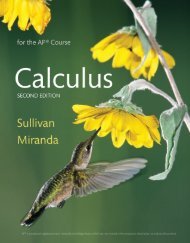SPA 3e_ Teachers Edition _ Ch 6
Create successful ePaper yourself
Turn your PDF publications into a flip-book with our unique Google optimized e-Paper software.
6<br />
Sampling Distributions<br />
Please read the Introduction to the Teacher’s <strong>Edition</strong>.<br />
It will help prepare you for teaching this course, as it<br />
includes a lot of helpful information and advice.<br />
The Big Picture<br />
This chapter focuses on sampling distributions. A sampling<br />
distribution describes the possible values of a statistic such<br />
as the sample mean x or the sample proportion p^ and how<br />
often they occur. Three characteristics of sampling distributions<br />
will be examined in detail: center, variability, and shape.<br />
These are the same three characteristics used in <strong>Ch</strong>apter 1<br />
to describe distributions of quantitative data. The mean and<br />
standard deviation measure the center and variability of<br />
sampling distributions. The shapes of sampling distributions<br />
will be described with the same terms in use since <strong>Ch</strong>apter 1:<br />
skewed left, skewed right, symmetric, mound-shaped, and a<br />
new term from <strong>Ch</strong>apter 5: approximately normal.<br />
The variables examined in this chapter are examples of<br />
random variables, which were introduced in <strong>Ch</strong>apter 5.<br />
The sample count X is a binomial random variable and<br />
is therefore discrete. The sample proportion p^ is closely<br />
related to the sample count X. Finally, the sample mean x<br />
is a continuous random variable.<br />
The process of making a conclusion about a population<br />
based on the data in a sample is called statistical inference.<br />
<strong>Ch</strong>apter 6 lays the foundation for the statistical inference<br />
techniques learned in <strong>Ch</strong>apters 7–10. <strong>Ch</strong>apter 6 describes<br />
the sampling distribution of a sample statistic when certain<br />
characteristics are known about a population. In future<br />
chapters, we will test claims and estimate population<br />
parameters using what we have learned about these sampling<br />
distributions, even when population characteristics<br />
are unknown.<br />
The sampling distribution of p^ , the sample proportion,<br />
and x, the sample mean, are of particular importance for<br />
<strong>Ch</strong>apters 7–9. In those chapters, the values of unknown<br />
population proportions and population means will be estimated,<br />
and claims about them will be tested. Furthermore,<br />
estimates will be made and claims will be tested about the<br />
difference in two proportions and the difference in two<br />
means.<br />
Pacing and Assignment Guide<br />
Day Lesson Learning Targets/Classroom Activities Suggested Assignment<br />
1 <strong>Ch</strong>. 6 Introduction Lesson 6.1 Activity: A penny for your thoughts? None<br />
2 6.1 What Is a Sampling<br />
Distribution?<br />
• Distinguish between a parameter and a statistic.<br />
• Create a sampling distribution using all possible samples from a<br />
small population.<br />
• Use the sampling distribution of a statistic to evaluate a claim<br />
about a parameter.<br />
1–15 odd, 19<br />
3 6.2 Introduction Lesson 6.2 Activity: How many craft sticks are in the bag? None<br />
4 6.2 Sampling<br />
Distributions: Center<br />
and Variability<br />
5 6.3 Sampling<br />
Distribution of a Sample<br />
Count (The Normal<br />
Approximation to the<br />
Binomial Distribution)<br />
• Determine if a statistic is an unbiased estimator of a population<br />
parameter.<br />
• Describe the relationship between sample size and the variability<br />
of a statistic.<br />
• Calculate the mean and the standard deviation of the sampling<br />
distribution of a sample count and interpret the standard<br />
deviation.<br />
• Determine if the sampling distribution of a sample count is<br />
approximately normal.<br />
• If appropriate, use the normal approximation to the binomial<br />
distribution to calculate probabilities involving a sample count.<br />
1–15 odd, 19<br />
1–15 odd, 19<br />
6-2<br />
C H A P T E R 6 • Sampling Distributions<br />
Starnes_<strong>3e</strong>_ATE_CH06_398-449_v3.indd 2<br />
11/01/17 3:51 PM




